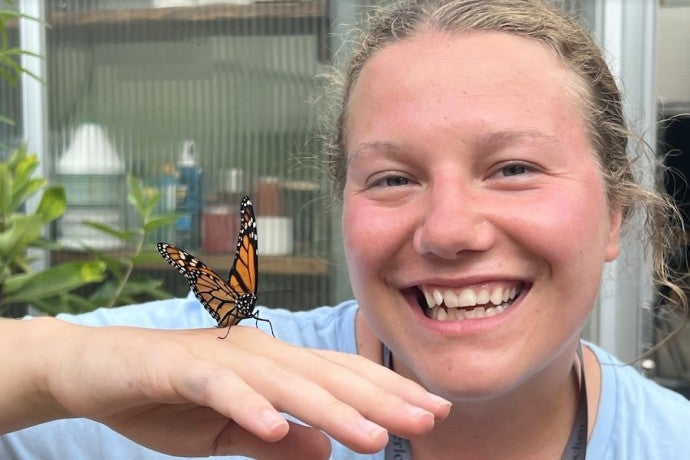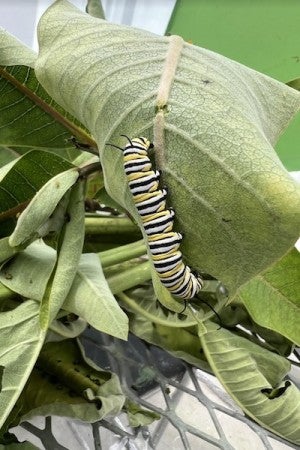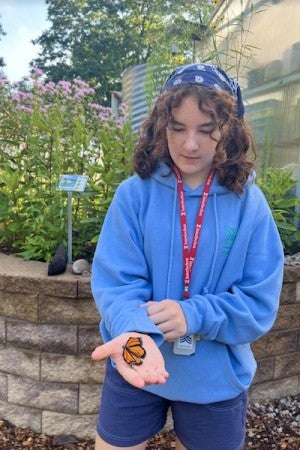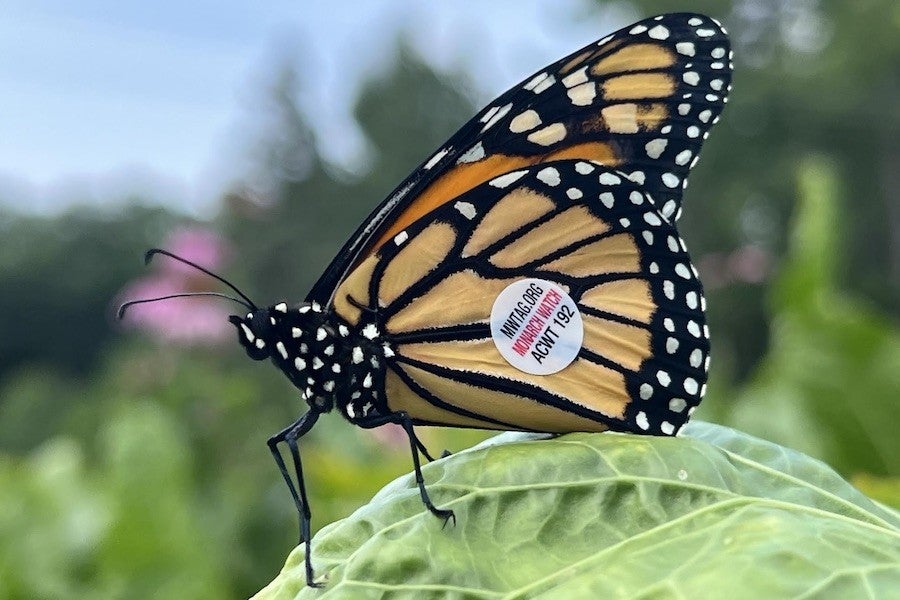Fly away, butterfly: Interlochen’s Sustainability Department raises and releases 50 monarch butterflies
The project, which involved Arts Camp students, staff, and faculty members, was part of an ongoing effort by Interlochen to support and raise awareness for this native species.

Kara Dutton, Interlochen Sustainability Garden Intern, poses with a newly-hatched monarch butterfly.
Late July of 2024 was a special time at Interlochen’s R.B. Annis Botanical Lab and Community Garden. Over the course of a few weeks, 50 monarch butterflies—carefully raised by Sustainability staff, faculty, and Arts Camp students—were released into the wild, free to fly wherever they wished.
With Eastern Monarch butterfly populations decreasing by more than 80% in the past 30 years, and Western Monarch populations falling by almost 95%, Interlochen’s efforts are a small but meaningful step towards supporting this beloved native species. For over five years, the Interlochen greenhouse has been tracking the migration of local monarchs as part of the University of Kansas’s Monarch Watch. This year, Interlochen's Sustainability Department, under the direction of Emily Umbarger, took the program to a new level by purchasing caterpillars from the University of Kansas to be raised at Interlochen.
Housed in mesh butterfly habitats and surrounded by their favorite food, milkweed, the 50 caterpillars enjoyed safety and plenty of resources while they transformed into chrysalises and then mature butterflies.
“Caterpillars stay in that stage for around 8-15 days,” Umbarger explained. “They grow larger and larger, shedding their skin five different times. After transforming into chrysalises, they spend 1-2 weeks that way and then emerge as adult butterflies.”

A monarch caterpillar feeds on a milkweed leaf.
A migration that defies all odds
Known for their distinctive orange-and-black patterned wings, monarch butterflies are also famous for their ability to migrate long distances—an incredible journey that Interlochen is helping to chart. Before being released, each Interlochen butterfly was tagged with a unique ID code. That way, scientists across the continent will be able to record where the butterflies travel.
“If scientists or fellow citizens capture these butterflies, they can go online and report this data,” says Umbarger. “Then we’re able to tell where our butterflies went and what they’re doing.”
Depending on the time and place of their birth, monarch butterflies have specific roles to play as either breeding adults or migrating adults. Breeding adults will fly about a third of the way through the annual migratory route before stopping to mate and lay eggs, while later generations of migrating monarchs fly somewhere around 3,000 miles to Mexico, where they will spend the winter.
Monarchs face all of these human challenges, in addition to natural predation and predators, while also navigating the fantastic metamorphosis that they have to go through. It's absolutely insane.
“It’s extraordinary that these tiny insects are able to migrate 3,000 miles and know how to get there,” Umbarger comments. “They aren’t doing it based on experience; they’ve never made the trip before. There are incredible forces of nature at play in their biology that make them uniquely adapted to navigating this journey.”
Although the navigation process is still very mysterious, scientists think that monarchs rely on an internal compass that’s oriented by sunlight and magnetism. By any account, the monarchs’ journey is nothing short of a miracle.
“Monarchs make their journey despite climate change, pesticide use, and habitat loss due to the logging industry in Mexico where they overwinter,” says Umbarger. “They’re facing all of these human challenges, in addition to natural predation and predators, while also navigating the fantastic metamorphosis that they have to go through. It's absolutely insane.”
Preserving a species while building awareness
The reasons behind Interlochen’s monarch-raising program are twofold: preservation and building awareness.
“In the wild, only a small percentage of monarch eggs actually hatch and make it through their larval stage to adulthood,” says Umbarger. “Protecting them through these vulnerable stages can help increase their numbers.”
The project isn’t just about supporting this generation of monarchs, though. It’s intended to raise awareness throughout the Interlochen community and beyond—potentially affecting the entire future of the species. It all starts with Interlochen Arts Camp, where young students are able to actively participate in raising the butterflies.
“At Camp, we spend a whole day talking about monarchs as part of the environmental studies program,” she says. “We teach students what's going on in the world of monarch butterflies, why we should care about it, how we can participate, and what we can do to help advocate and spread information about them.”

An Intermediate Arts Camp student holds a monarch.
Every time her students get the chance to interact with the developing monarchs, Umbarger sees lightbulbs go on.
“The monarch life cycle and metamorphosis is a fascinating process for students to wrap their head around,” she says. “My students especially love learning about how the caterpillar’s entire cellular structure is broken down into a soupy primordial substance inside the chrysalis, and then they come out looking completely different. That always blows their minds.”
Umbarger urges her students and the community at large to do their part in protecting the species.
“The first thing we can do is stop spraying harmful pesticides,” she says. “We can also plant native perennial plants that provide habitats for our local species. What's most important is that you plant native milkweed species that are indigenous to your particular growing area. There are lots of species of milkweed out there, so you want to grow species that belong there.”
The most important thing, says Umbarger, is to continue spreading awareness through conversations with others.
“People are more likely to listen to their neighbor than some information they find online,” she notes. “Just having a conversation with someone is a really powerful tool.”
As bright orange and black wings filled the air this July, the Interlochen community celebrated the beauty and resilience of the monarch butterfly. There’s no doubt that Interlochen’s support for this amazing species will only grow in the years ahead.
Interlochen’s Sustainability department seeks to inspire the local community—and the next generation—with a deep understanding of how much they depend on the natural world. Learn more about Sustainability at Interlochen.




